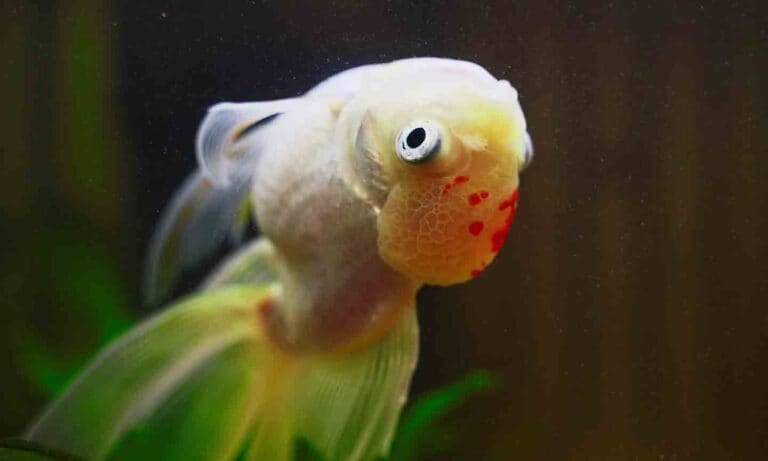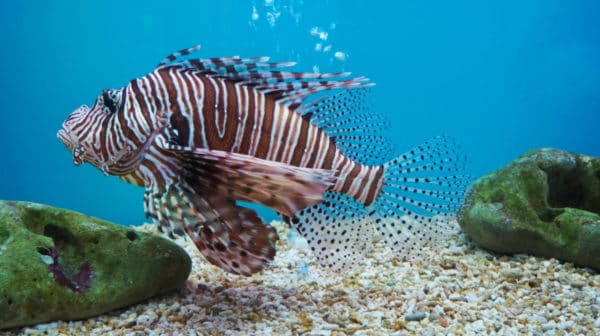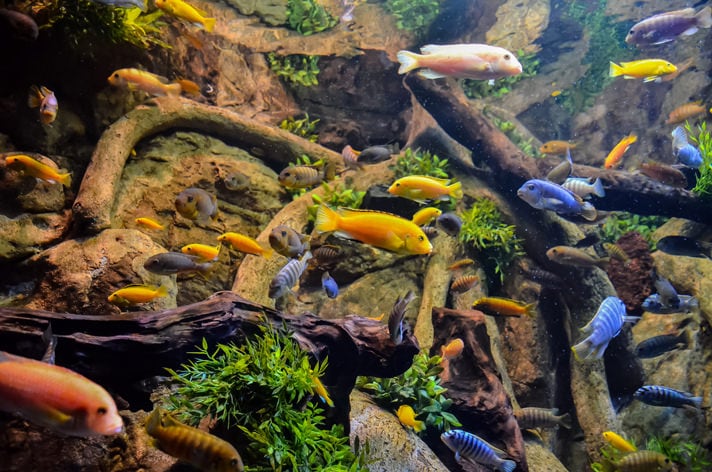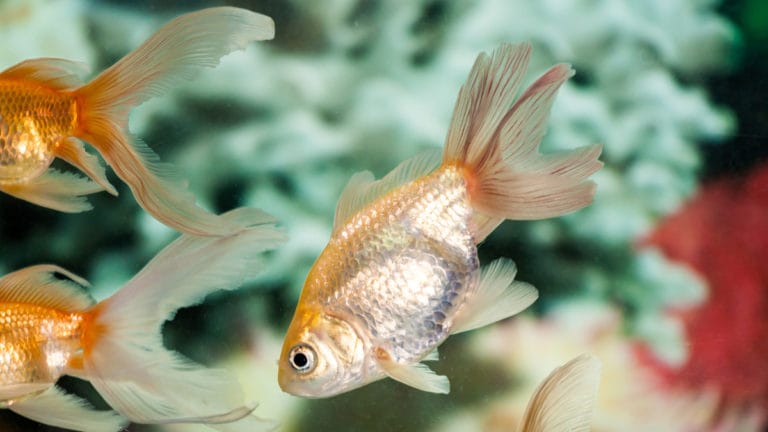Many fish are prone to constipation when fed a flake- or pellet-based diet, including goldfish, cichlids and surgeonfish. Left untreated, constipation can lead to a variety of serious problems, including swim bladder disease and loss of appetite.
Identification
Constipation in fish is typically revealed by bloating and the production of stringy feces. Normal fish feces will immediately fall to the substrate; constipated fish feces will appear stringy and hang from the fish. Fish with chronic constipation tend to be lethargic, disinterested in food and generally out of condition. In severe cases, constipation can make it difficult for a fish to swim normally. Constipation can be confused with dropsy, but while fish with dropsy are bloated and lethargic, they also have raised scales that stick out from the body, resulting in a characteristic pineconelike effect when viewed from above.
Hexamita infections are particular to perciform fish, such as cichlids and surgeonfish, species that often become constipated in captivity. Both constipation and Hexamita infections result in the production of large quantities of feces. Constipation doesn’t affect how much feces a fish makes, but how easily it can get rid of them. However, because Hexamita infections stimulate the bowel to secrete excessive amounts of mucus, the resulting feces are distinctively pale in color and slimy in appearance.
Pathology
Constipation is caused by a diet that lacks the necessary indigestible matter known as dietary fiber. Dietary fiber enables the digestive tract to function properly. If there isn’t enough fiber in a fish’s diet, feces are not easily pushed out, leading to loss of appetite, lethargy and buoyancy problems often described as swim bladder disease.
In the wild, herbivorous and omnivorous fish consume plants, algae and decomposing organic detritus containing large amounts of fiber. Predators consume some fiber indirectly through the gut contents of their prey. But indigestible parts of their prey (such as the chitin-rich skeletons of crustaceans) are another important source of dietary fiber.
Pellet and flake fish food contain little (if any) fiber. Fish fed an exclusively flake- or pellet-based diet are prone to constipation. Freeze-dried foods are similar, and are best used as treats rather than staple foods.
Without exception, fish should be fed a varied diet containing a lot of green, fresh, live or frozen foods, depending on the species in question. In the case of herbivores and omnivores, green foods should make up the bulk of the diet. Carnivores should receive a diet containing whole prey animals so that they get not just the energy and protein they need, but also the indigestible skeletons and gut contents, as well.
Physical exercise is important, and constipation is commonly seen in fish such as bettas that are kept in quarters too small to allow them to swim about. Fancy goldfish and blood parrot cichlids are further crippled by having unnatural body shapes that make swimming difficult at the best of times, and when constipated the distorted arrangement of the swim bladder and digestive tract makes them particularly prone to swim bladder problems.
Treatment
Constipation is treated primarily by providing high-fiber foods that can act as a laxative. During the treatment phase, no other foods should be given (and certainly not pellets, flake or freeze-dried foods). Tinned peas are the classic laxative for most fish, either whole (in the case of species like goldfish) or squashed (for smaller species, such as bettas). Other good foods include plants (particularly Elodea and Egeria) and chitinous live foods (such as Daphnia and brine shrimp). Epsom salt (magnesium sulfate) is a mild muscle relaxant used when treating moderate to severe constipation. Depending on the severity of the case, a dosage of 1 to 3 teaspoons per 5 gallons is recommended.
Prevention: Fiber-Rich Foods
Preventing constipation in fish is easy and inexpensive. Herbivorous fish should simply be fed a lot of green foods instead of pellets or flakes. Algae contains some cellulose, but there is generally not enough to satisfy fish in the average aquarium. Goldfish, severums, silver dollars and mbuna are examples of fish that will happily graze on soft aquatic plants in lieu of other foods. Bunches of cheap aquatic plants, such as Elodea Canadensis and Egeria densa, are widely sold and inexpensive, and will do the trick nicely. Because plants contain very little nitrogen, even when decaying they have minimal impact on water quality. Adding a couple of bunches of cheap aquatic plants to your tank before you go away on vacation is one of the safest and least expensive ways to ensure your fish have something to eat while you are away.
Other good green foods include tinned peas, blanched curly lettuce, spinach and thinly sliced cucumber. Suckermouth catfish (family Loricariidae) will also graze on various fruits and tubers, including zucchini, carrot and sweet potato. Some suckermouth catfish appear to consume wood as a natural part of their diet (some species as a source of energy) but mostly as a source of dietary fiber. Consequently, suckermouth catfish should be provided with a piece of bogwood to graze on.
Contrary to popular belief, there is rarely enough algae in home aquaria to support the needs of marine herbivores, such as surgeonfish and angelfish. These species should be provided with a suitable alternative. While blanched curly lettuce and spinach have been used in the past, dried algae sheets known as nori are now recommended. Because nori is made from marine algae, it is assumed to be a better food for freshwater fish than terrestrial plants. Nori is inexpensive and widely sold in Asian food stores as well as many grocery stores.
Posted by: Chewy Editorial
Feature Image: Brian Kinney/Shutterstock
Fish Health and Wellness
Share:













